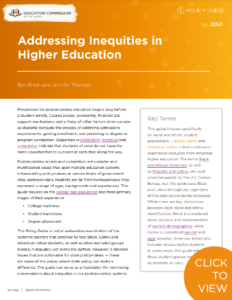Although diversity in higher education has continued to increase over the past 20 years, colleges and universities continue to enroll Black, Latinx and American Indian students in bachelor’s programs at low rates; additionally, more selective institutions and high-demand fields of study are less likely to enroll these students, and they often are not afforded the supports and services that can help them finish college or obtain a degree. These disparities have a significant impact on the long-term employment outcomes for students, and they maintain a racial and ethnic wealth gap — both problematic scenarios for state policymakers looking to build a prepared workforce and resilient economy.
This Policy Guide explores various types of barriers that these students face in:
- College readiness. This includes inadequate access to advanced coursework, counseling and financial aid resources that prepare students for college or university.
- Transitions to college. Black, Latinx and American Indian students are more likely to be directed into developmental education coursework, which does not count toward a degree.
- Degree attainment. Financial need and experiences with racism on campus, among other factors, disproportionately impact these students and potentially drive them to dropout. This trend not only leaves students without a credential, but often with high levels of debt.
While this guide is not an exhaustive examination of the systemic barriers that exist, it elevates issues along the higher education pipeline that are actionable for policymakers.
This is a companion resource to “State Policy Options to Promote K-12 Integration,” which explores three types of K-12 segregation — across districts, between schools in a district and within schools — and provides policy considerations and examples of state initiatives that address each.



